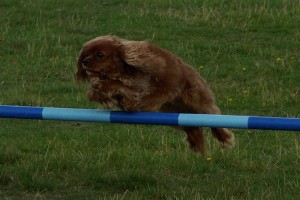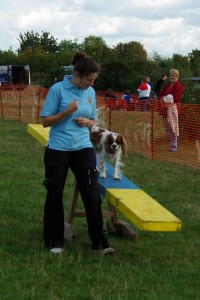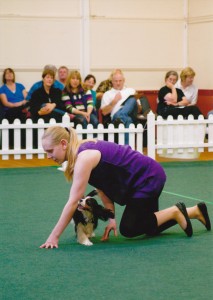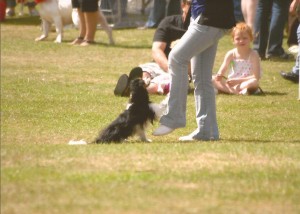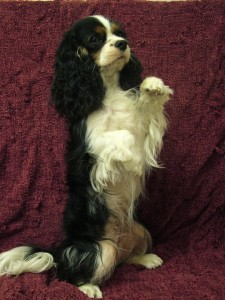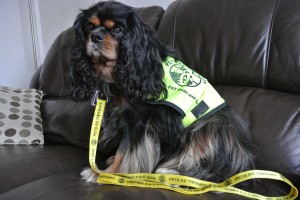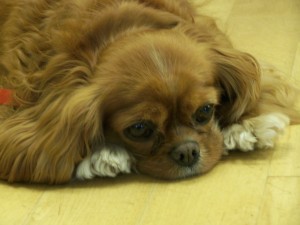A dog is the only thing on earth that loves you more than he loves himself.
– Josh Billings
There are many activities you can do with your cavalier. Below are a few things that some of our members and their dogs do together.
CLEVER CAVALIERS DISPLAY TEAM:
The team got together in 2002 from a shared interest in Cavaliers, their underestimated ability to achieve so much and the desire to raise money for research into Cavalier diseases and for Cavalier rescue.
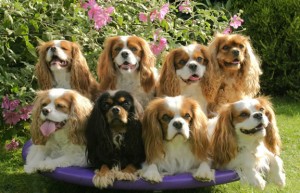 The team has changed over the years as people and dogs have come and gone. It takes a huge commitment to be a team member with training and displays once a month, and the dogs always have to look their best. The displays can be for care homes, stroke clubs, youngsters with special needs, Help The Aged, Age Concern and so on – in all sorts of venues. Some of these can be difficult as the room is very small, but in others we have a huge space. The dogs are bomb-proof and put up with people walking through the middle of whatever they are doing, try to ignore tea and cakes which are always on the bottom of the trolley and general noise and hubbub. They have all been temperament assessed and many of them are PAT Dogs.
The team has changed over the years as people and dogs have come and gone. It takes a huge commitment to be a team member with training and displays once a month, and the dogs always have to look their best. The displays can be for care homes, stroke clubs, youngsters with special needs, Help The Aged, Age Concern and so on – in all sorts of venues. Some of these can be difficult as the room is very small, but in others we have a huge space. The dogs are bomb-proof and put up with people walking through the middle of whatever they are doing, try to ignore tea and cakes which are always on the bottom of the trolley and general noise and hubbub. They have all been temperament assessed and many of them are PAT Dogs.
At Christmas we raise money for a local hospice by wearing Santa Suits and the dogs wearing festive scarves. We meet up for lunch and take the collecting box round the pub with their permission.
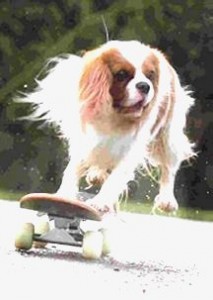 The team started when my dog Jensen won a trick competition at Discover Dogs in London with his skateboarding. The press took masses of photos and from then on the dogs were on television a lot, including Blue Peter where they all got their badges! They appeared on CBeebies, German TV, radio and in many magazines and papers. Hello and the Daily Telegraph being two of them. They were asked to perform at the Cavalier Show at Blenheim Palace and invited to do a display at Crufts four years running. They also did a display at Discover Dogs.
The team started when my dog Jensen won a trick competition at Discover Dogs in London with his skateboarding. The press took masses of photos and from then on the dogs were on television a lot, including Blue Peter where they all got their badges! They appeared on CBeebies, German TV, radio and in many magazines and papers. Hello and the Daily Telegraph being two of them. They were asked to perform at the Cavalier Show at Blenheim Palace and invited to do a display at Crufts four years running. They also did a display at Discover Dogs.
A huge amount of fun has been had by us all over the years and the dogs have been wonderful, always ready to do their best. We never force the dogs do anything – if they don’t want to do a trick on the day we just move on to the next. They have invented their own tricks from time to time too which we include. They are of course trained with plenty of treats.
We owe these clever little cavaliers an enormous thank you!
D. P.
Clever Cavaliers Training:
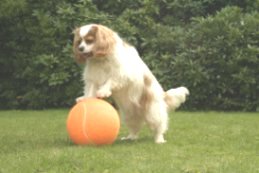 The best type of dog for a display dog is one that is full of enthusiasm and in-your-face, keen to learn and a show off. Shrinking violets are a struggle to teach and they can get over-faced in some of the situations we find ourselves in which isn’t fair to them.
The best type of dog for a display dog is one that is full of enthusiasm and in-your-face, keen to learn and a show off. Shrinking violets are a struggle to teach and they can get over-faced in some of the situations we find ourselves in which isn’t fair to them.
We start with basic obedience. Come, down, sit and a retrieve. Then touch with nose or feet. A lot of the tricks require holding items and touching things. Some heelwork to music moves are good as is the ability to do some agility. All the dogs need to be relaxed around people and able to cope with noise. They love to be applauded as we clap to show they have done a trick correctly when we train. We also clicker train.
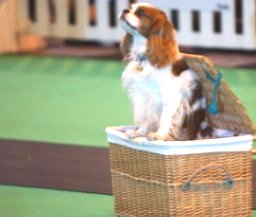 Sometimes with a complicated trick we start at the end of a trick and break it down into chunks, and then later on put the whole sequence together. For instance, if we were trying to teach them to post a letter into a post box we would start by encouraging them to put their head through the opening by drawing them through with a treat. (We have a door on the back of the box). Then we would hand them a letter to hold and say ‘drop’ and treat. We would progress by handing them a letter further away and getting them to come to the box. All the while we are at the back of the box. Once they have mastered that, it is an easy step to be in front of the box, to hand them the letter and send them to the box with a ‘drop’ command. The trick is then complete. Much easier than starting the other way round. Over the years we have worked out all sorts of ways of training them and if you have an eager dog who wants to please it makes it easier.
Sometimes with a complicated trick we start at the end of a trick and break it down into chunks, and then later on put the whole sequence together. For instance, if we were trying to teach them to post a letter into a post box we would start by encouraging them to put their head through the opening by drawing them through with a treat. (We have a door on the back of the box). Then we would hand them a letter to hold and say ‘drop’ and treat. We would progress by handing them a letter further away and getting them to come to the box. All the while we are at the back of the box. Once they have mastered that, it is an easy step to be in front of the box, to hand them the letter and send them to the box with a ‘drop’ command. The trick is then complete. Much easier than starting the other way round. Over the years we have worked out all sorts of ways of training them and if you have an eager dog who wants to please it makes it easier.
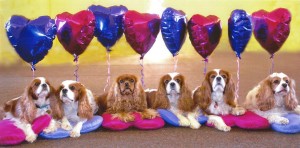 The down side of all the tricks is that we have to lug vast amounts of props around to every venue and we could really do with a truck and a gofer!
The down side of all the tricks is that we have to lug vast amounts of props around to every venue and we could really do with a truck and a gofer!
D.P.
Kennel Club Rally:
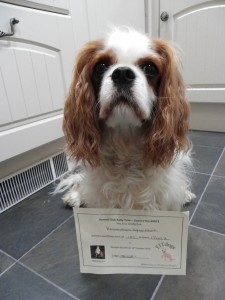 Lola and I discovered the sport of Rally through a taster session run by some members of The Companion Cavalier Club. At the time we were working through our KC Good Citizen classes and enjoying some fun agility, but were looking for a fresh challenge for us both.
Lola and I discovered the sport of Rally through a taster session run by some members of The Companion Cavalier Club. At the time we were working through our KC Good Citizen classes and enjoying some fun agility, but were looking for a fresh challenge for us both.
We immediately found Rally an enjoyable experience as it is all about developing the bond with your dog and you both working together to complete a series of signs around a course whilst losing the fewest number of points. After that initial taster session we were then on the hunt for a Rally Club for us to both learn and develop our skills in what we thought would just be a fun bit of training for us both. How wrong we were?
We found a place at Leamington Dog Club – KC Rally section, with an incredible and inspiring trainer who always encouraged us to keep going even when we struggled. Her dedication and passion for the sport was infectious and we soon found ourselves competing at KC trials. I would be lying if I said we had found competing easy; we’ve had a lot of non-qualifying scores for a variety of misdemeanours caused by either one of us; but with lots of hard work and positive training we’ve finally achieved our first Qualifier at Level One and Level Two, hopefully soon we will achieve our Level One Title.
I am also now one of the trainers at our club and love passing on what I have learned to my students; in fact I currently have two Cavaliers in my class and hope to see them out competing very soon.
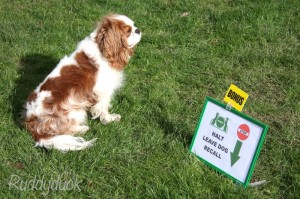 So what is Kennel Club (KC) Rally? Rally is a dog sport where the dog and handler navigate a course made up of a series of signs each asking for a different activity from the team. These signs can take various forms, such as: weaving through cones; asking the dog to sit or down at your side; turning to your left or right; asking the dog to sit or down whilst you walk around them etc., there are simply too many possibilities to list.
So what is Kennel Club (KC) Rally? Rally is a dog sport where the dog and handler navigate a course made up of a series of signs each asking for a different activity from the team. These signs can take various forms, such as: weaving through cones; asking the dog to sit or down at your side; turning to your left or right; asking the dog to sit or down whilst you walk around them etc., there are simply too many possibilities to list.
You start from a position of having 210 points (assuming you’re doing the bonus) and have points deducted for completing the signs incorrectly. There are 6 levels of competition, and levels 1 & 2 are completed on lead, whilst levels 3-6 are completed off lead. To progress through the levels you require 3 qualifying scores of 170 or more at each level.
Whether you choose to compete or simply just train at Rally for fun it is a wonderful sport for helping to develop the bond with your dog and is one that even the most stubborn Cavalier can thrive in. I find no deeper joy than working a course with Lola and seeing her happily wagging her tail all the way round, even on the days when that is all she’s willing to do! I urge you all to simply have a go and see how much fun you can have. You may surprise yourselves…and I’ll look forward to seeing you at KC trials in the near future!
For further information take a look here.
C P
Cavaliers and Agility:
Agility is a sport that has been around for many years but it isn’t just for Border Collies and other working breeds. I see all sorts of shapes and sizes around the agility circuit but Cavaliers always get an ooh and an ahh from spectators. I’m told it’s something to do with the flying ears!
I am fairly new to it as far as years go as Ruby is 5 and has been competing for 2 seasons but I only went for fun and exercise to begin with. Apparently there is a bug that you catch and I sure did and have held it ever since. It is important that there is an element of obedience training to start with, Agility is a very high energy sport and dogs can easily get ahead of themselves and play up if not trained in the first place. We train once a week and compete twice a month through out the spring-autumn season, camping most of the time with a group of friends. It is a very sociable sport and you meet many friends along the way.
There are two main organisations in the UK that run Agility competitions, the Kennel Club dominates the show circuit and through out the season KC clubs are running competitions every weekend up and down the UK. Regional and Local agility training clubs will register for KC licence and adopt their rules and regulations and run shows through out the year. To compete with a dog in a KC show, the dog needs to be registered under the KC. This doesn’t mean that rescues can’t compete, you can apply under the Activity Register for a small fee and that way you get the fun job of choosing a fancy name for your dog! Once a dog is registered you can compete in all areas of activities, including Agility, Obedience and Flyball, but not breed shows. For more information visit the KC website.
You can find out more about applying for KC registrations from their Application Form
The other organisation is the British Agility Association (BAA), it is smaller and newer, created by a lady called June Bass. It was created by June as an alternative to the KC, it has different rules and regulations that in my opinion are far more user friendly and created with the dogs welfare as top priority. The shows are much smaller compared to Kennel Club events and the rings are fenced in for the dogs safety. There is no KC registration necessary and it has its own leagues, the finals take place once a year in August up in Leicester. I find the BAA rules and shows are perfect for Cavaliers that aren’t known for their recall ability and let’s face it; they are Spaniels and chase things that they shouldn’t! The jumps are lower and the atmosphere from experience is just calmer and more about the dogs than the competing. For more information about BAA .
The main place to research agility and find shows is AgilityNet where you will find shows and schedules for all organisations (including KC and BAA) and it also has forums, flea markets and an A-Z listing of clubs around the UK. We cannot recommend any of the clubs listed and we advise anyone looking for a training club to visit in advance and watch a class taking place. Reputable clubs will not allow dogs under the age of 12-18 months to train and will use only positive reinforcement methods of training.
The relationship that develops between you and your dog when doing any kind of activity is truly wonderful, dogs were all bred with a purpose and a job to do and even though the Cavalier was once a Comfort Spaniel for royalty, they are a sporty and energetic breed and excel in the agility ring!
K.B.
Cavaliers and Obedience:
Ruby at Obedience Training
Competitive Obedience is a sport, and has been such since the early 1950’s. People probably get involved in Obedience in the first place through Dog Training Clubs. Not all people who go to DTC’s are there to train their dogs for competition (in fact only a small proportion go on to this), the majority only going to give their dogs basic obedience and ‘socialisation’ with other dogs.
Those that stay long enough at the club may first go on to attend and ‘compete’ in those Companion Dog Shows that have Obedience Classes. For the majority of Companion Dog Shows you just ‘show up’ and enter a Class on the day, for which you pay a nominal entrance fee, which generally goes to charity or the clubs funds (note that most DTC’s are non-profit making).
To join a DTC you don’t have to register your dog with the Kennel Club, or to enter Exemption Shows. However, when you compete in Club Matches with other KC registered clubs or enter Limit or Open Shows, your dog has to be registered (even rescue dogs, and crossbreeds have to be registered in their case, under the Obedience and Working Trials register). To find out more about registering a dog.
Limit , Open and Championship Shows are run ‘by the Kennel Club’ and ‘Under Kennel Club Rules’. Each Show will have a ‘Closing Date’ for entries a few weeks before the actual event, which means you must pre-book your place, and pre-pay your entrance fee (around £4 to £5 per Class). Classes at these Shows are known as Pre-Beginner, Beginner, Novice, ‘A’, ‘B’, ‘C’, and Championship ‘C’ (in ascending order of ability / experience), and the ‘Tests’ to be performed for each of these Classes is predefined in the Kennel Club rules. In general you have to win twice in a lower class to progress on to the next level. Only winners of the Championship ‘C’ Class (which are only at Championship Shows) go on to compete at Crufts. Read more about KC Obedience.
Cavaliers have such a wonderful presence and personality that they really shine in the ring. To get a Cavalier to the standard needed for competing takes hard work and training (and plenty of sausages!) but the rewards are endless. I have been competing with my eldest Cavalier for a couple of years, we have never won out of our class but I don’t do a lot of shows through out the year. Splitting the season between two dogs and two different sports is hard work!
For me it isn’t about winning, it’s about having that special time together where I can show everyone watching how special and beautiful my Cavalier is…. Who needs a Collie??
K.B.
Working Trials:
Working Trials is the oldest of all dog sports. The work is divided into three sections, Nosework, Agility and Control.
This link will take you to the Kennel Club page regarding Trials. http://www.thekennelclub.org.uk/activities/working-trials/
Details of what’s involved can be found here http://www.thekennelclub.org.uk/media/31574/working_trials.pdf
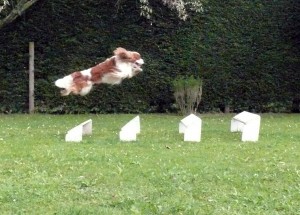 There are four Stakes and small breeds can only compete in the lower two because the powers-that-be refuse to have the jumps reduced in accordance with the dog’s size, which is what happens in the lower two Stakes.
There are four Stakes and small breeds can only compete in the lower two because the powers-that-be refuse to have the jumps reduced in accordance with the dog’s size, which is what happens in the lower two Stakes.
The Stakes are Companion Dog (CD) Utility Dog(UD) Working Dog (WD) and Tracking Dog.(TD) There is an optional Stake called Patrol Dog which involves Man Work.
The Nosework is a Retrieve, a Search and in UD, a Track.
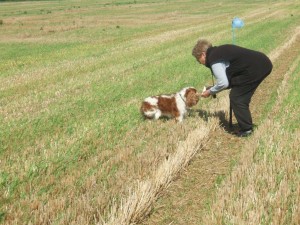 For the Search, 4 poles are put in the ground to make a square. In CD this is 15m x 15m, in all other Stakes it’s 25m X 25m. Depending on the Stake, small articles are put in the square by the steward, 3 in CD and 4 in UD. Four minutes are allowed to find them in CD and 5 minutes in UD. Typical articles are a gun cartridge, a dolly peg, a teaspoon or a small piece of carpet, lino or cloth.
For the Search, 4 poles are put in the ground to make a square. In CD this is 15m x 15m, in all other Stakes it’s 25m X 25m. Depending on the Stake, small articles are put in the square by the steward, 3 in CD and 4 in UD. Four minutes are allowed to find them in CD and 5 minutes in UD. Typical articles are a gun cartridge, a dolly peg, a teaspoon or a small piece of carpet, lino or cloth.
Billy is shown doing his search square.
![]() The track is at least half a mile long and for UD typically has 8 – 12 legs, laid by a stranger and half an hour old. There is one article on the track and one at the end. The dog is on a harness and line for this.
The track is at least half a mile long and for UD typically has 8 – 12 legs, laid by a stranger and half an hour old. There is one article on the track and one at the end. The dog is on a harness and line for this.
Billy is shown doing the last third of a track.
The Agility consists of 3 jumps, a clear jump, a long jump and a scale. For a Cavalier that’s a 2’ clear, a 6’ long and a 4’scale. The dog has to wait, then jump, then go down or sit, to show control. The handler has to remain still throughout.
The Control for CD consists of Heelwork on Lead and Heelwork off lead, at all three paces. There is a recall with finish, a sendaway, a 2 minute sit stay and a 10 minutes down stay both out of sight. At UD level, a steadiness to gunshot is added.
Heelwork, Retrieve and Recall have to be done with no extra commands. For example, it’s “close” as you begin the HW, then the whole HW pattern, in all three paces has to have no further commands.
You have to attain 70% of the total marks in all three sections AND get 80% overall to qualify for those magic letters after the dog’s name!
Most Trials are held over the winter when there is an abundance of farmland with some growth of crop to track on, but in the Autumn we often track on stubble or rolled plough and in Scotland, on heather and bracken with boulders underfoot! Trials is totally dependant on the good nature of farmers for the use of their land.
When I first had Billy, I was already competing in Trials with Baillie (Beardie X Border Collie). I cannot really remember starting Billy’s training for Trials, but he learnt all the exercises extremely quickly, never tired and was, and is, always up for it. He certainly epitomises the “sporting” part of the breed standard as it took only about 18 months to teach him the skills but another 2 years to stop him chasing birds! He could always jump like a flea. To compete in Trials, jumping ability is the make or break section.
He has qualified twice. He got his CDEx at a Trial in Scarborough and came 4th out of 23 and qualified UD CoM (Certificate of Merit) 186/200 marks and came third out of 17. Virtually all the other dogs in Trials are German Shepherds, Border Collies, Labradors and Golden Retrievers. He just has to get that UDEx now!
A. T.
Cavaliers and Heelwork To Music:
Heelwork To Music started back in 1990 when Mary Ray did the first authenticated performance of its kind. Back then ‘Heelwork To Music’ was exactly that, a round of obedience heelwork with music playing, nowadays there are two sections.
The first section is heelwork to music where the dog has to work off lead in a heelwork position which you have a choice of eight. These can be viewed on this link: The routine has to contain a minimum of two thirds heelwork and can contain no more than one third freestyle.
The second section is freestyle where the dog works off lead in any position and can contain no more than one third heelwork. Over the years that name has stuck even though it’s no longer heelwork to music. Since it first started the sport has grown from strength to strength and in 2002 the Kennel Club formally recognised Heelwork To Music as a competitive sport.
In both Heelwork To Music and Freestyle there are four classes; starters, novice, intermediate and advanced and you win out of these classes by points. You can find the marking criteria here:
My journey into the heelwork to music work, I guess, started on the 3rd of October 2008 when I picked up my 12 week old tri-coloured cavalier king charles puppy, Kiara. When I started Kiara’s puppy training I used to teach her the odd trick for fun and for her to focus on while we were waiting in the classes. In December that year, I was competing in an agility competition with Jess, a cross breed I was borrowing. During the day, I got Kiara out for a little walk and I started doing a few tricks with her, on the walk a lady approached us and asked a few questions, I then found out that she was doing a heelwork to music display and she invited us into the ring to show us some more tricks. That was the day I ‘caught the bug’!
From that day I started looking into heelwork to music a lot more and taught kiara more and more tricks. In May 2009 I attended my first heelwork to music workshop which was run by Annette Leslie and Mary Ann Nester, two great people, who, to this day have helped me so much which I’m so grateful for as I don’t think I would be where I am without their help.
- I picked up a lot of training tips and put it to work, after a while I decided to put a routine together and in March 2010 we entered our first heelwork to music competition. With Kiara still being fairly young at the time, she was very distracted in the ring and unfortunately we didn’t get placed. A little while after the competition, i started heelwork to music classes and later on that year, Annette and Mary Ann invited me to a Richard Curtis training day. After seeing him train his own dogs it really opened my eyes to a different training method and that was when I decided to wipe the slate clean, I chose a new piece of music, came up with a new routine, a new theme and we entered another competition in September that year, and, well the hard work paid off because we won the class!
A month later we were entered in another competition and came second, which meant we had won out of starters and into novice. In 2011 we continued with the same routine and gained 6 points, needing only 10 more to win into intermediate. During the year there was an inter regional heelwork to music competition, the first of its kind, and Kiara and I felt so honoured to represent the midlands team in the novice freestyle class.
In all, heelwork to music gives people a great opportunity to have fun with their dog, be creative and most importantly, creates a strong bond between you and your dog!
J.B.
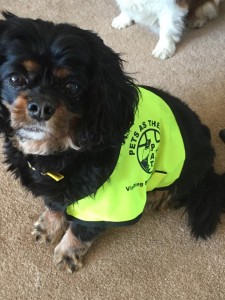 Pets As Therapy ( PAT ) Dogs:
Pets As Therapy ( PAT ) Dogs:
Having owned Cavaliers for over twenty years I still experience a frisson of expectant joy on waking every morning, knowing that I will be greeted by wagging tails, gentle loving eyes and an exuberant welcome that can lift my spirits on even the coldest winter Monday morning. Cavaliers certainly get me out of bed and I feel privileged to own them.
I joined Pets as Therapy in 2006 because I wanted to share this joy with others who I felt would have their lives enriched by interacting with my dogs. Their friendly, gentle nature and obvious love of people makes this breed ideal candidates for Pets As Therapy and both my dogs obviously enjoy their visits and the dog treats too I suspect! In 2008 I became a dog temperament test assessor for the charity and never had to refuse a cavalier owner applicant.
Many a time I have had a lump in my throat whilst visiting. I visited a stroke patient who had not spoken for weeks and lay in bed all day a care home in a depressive state. Playing her family’s voices on tape, her favourite music, comedy TV etc had no effect.Then a relative suggested I place my blenheim Darcy on her bed as she had owned and loved dogs in happier days. Initially there was no reaction and then one day Darcy sniffed her face and she uttered “dog” . Within a few weeks she was up and interacting with other residents in the day lounge. She told me Darcy saved her life and cherished our weekly visits. Another resident who had no living relations or visitors had her hair done weekly “for the dog”. Our visit was the high point in her week.
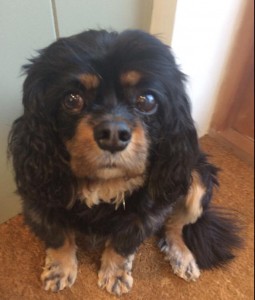 I visit a primary school with Pickle my black and tan and have lost count of the number of children who have overcome their fear of dogs .Within a few weeks withdrawn children are doing basic training and calling out commands. Sometimes children going through a bad time just come for a cuddle with him on the beanbags to experience the calming effect of stroking a dog. They often voice their fears and troubles whilst grooming him and teachers are often amazed by his empathy and seemingly sixth sense in identifying a particularly troubled child. He obviously loves interacting with the children too so it is a mutual benefit. An added bonus is that children learn about how to behave around animals, respect and be responsible for them. Pickle has now become the school mascot and was given a personalised bandana emblazoned-with the school crest which he wears to special assemblies and sports days. Teachers too come for a Pickle cuddle to alleviate the stress teaching can bring.
I visit a primary school with Pickle my black and tan and have lost count of the number of children who have overcome their fear of dogs .Within a few weeks withdrawn children are doing basic training and calling out commands. Sometimes children going through a bad time just come for a cuddle with him on the beanbags to experience the calming effect of stroking a dog. They often voice their fears and troubles whilst grooming him and teachers are often amazed by his empathy and seemingly sixth sense in identifying a particularly troubled child. He obviously loves interacting with the children too so it is a mutual benefit. An added bonus is that children learn about how to behave around animals, respect and be responsible for them. Pickle has now become the school mascot and was given a personalised bandana emblazoned-with the school crest which he wears to special assemblies and sports days. Teachers too come for a Pickle cuddle to alleviate the stress teaching can bring.
I have witnessed a head teacher who was extremely reluctant to have a dog in school as she disliked dogs intensely, line up the whole school in the playground to meet Pickle. As well as overcoming her personal fear, she pleaded with us to make weekly visits.
Pets As Therapy are desperate for more volunteers and those of us who own this delightful breed , and can commit to a few hours a month can help spread the joy dogs bring and add a new dimension to people’s lives. They have a very informative website www.petsastherapy.org
which should answer any questions you may have but please feel free to contact me either through the companion cavalier club facebook page or my email Ollytol@nullaol.com. This year ( 2015 ) I am fortunate enough to be representing PAT on their stand at Crufts on the Sunday with Pickle. We will be taking part in the parade of PAT dogs so if you are there please come and say hellos.
PAT needs your dogs! Thanks for reading this and please consider joining us.
O. T.
I feel very privileged to be asked to give my input on something which Mia and I are part of and have the pleasure of belonging to ‘another family’.
Thanks to being a member of the Companion Cavalier Club, I attended a Cavalier Christmas Party in 2013 with my four Cavaliers Gracie, Lilly, Mia and Aimee. Amongst lots of fun and games and a visit from Santa, a speaker had been organised from Pets as Therapy who gave a very interesting talk on the joys and rewards from these visits, it was here I realised I wanted to offer some of this happiness with one of my girls.
Pets as Therapy is a charity run organisation. 28,000 dogs have been registered as PAT dogs, 4,500 are currently active, of which I am proud to say Mia and I contribute towards that number. 108 PAT Cats are also currently active assisting the organisation.
Where to start…..well first and foremost having the honour of being owned by four Cavaliers it was making a choice which dog would fit the criteria the best. By process of elimination Mia, my little black and tan bitch who was 2 years old at the time seemed the ideal candidate. I contacted the charity and received a welcome pack, explaining and detailing things very well.
Assessment……after contacting the local co-ordinator whose details are supplied for you, a visit was arranged for Mia and I to meet an assessor. This is someone who we had never met. We met on a car park close to a Pets at Home, after a warm welcome it became apparent Mia was under her watchful eye. The criteria overall is that the dog doesn’t ‘tap’ (risk of damaging thin skin in patients), has patience and does not bark or whinge to move on, does not jump up, is gentle when receiving treats, is not afraid or too jumpy by loud or sudden noises or movements, and resisted picking up treats walking round the pet shop, and of course was clean and well groomed.
At the end of the assessment we were told that Mia and I were suitable candidates, whereby two references were applied for as character references for myself.
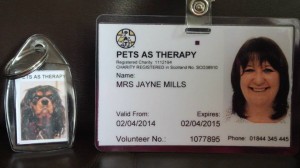 Mia and I were absolutely delighted when all the above came back as a PASS…..now onto the real work. Again we contacted our local co-ordinator who has a list of locations awaiting visits. As I had recently lost my loved dad with dementia and knew how much pleasure he had gained from family pets, my heart lay with giving a little happiness back to people in such a situation. We were offered a local residential nursing/care home whereby we arranged a visit and guided tour where agreement was made this was a mutual ideal location.
Mia and I were absolutely delighted when all the above came back as a PASS…..now onto the real work. Again we contacted our local co-ordinator who has a list of locations awaiting visits. As I had recently lost my loved dad with dementia and knew how much pleasure he had gained from family pets, my heart lay with giving a little happiness back to people in such a situation. We were offered a local residential nursing/care home whereby we arranged a visit and guided tour where agreement was made this was a mutual ideal location.
I took the advice from the co-ordinator to initially book a fortnightly visit and so we commenced.
Our assessment was exactly one year ago, and we have been visiting now for approximately 7/8 months and love every visit. The location we chose has four different wings of patients with different levels of dementia and illness. From arrival onto the car park Mia cries with joy and excitement, we always have a word at the entrance door whereby I remind her of ‘manners’!
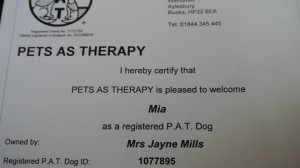 It is clear that Mia brings so much warmth and happiness; smiles greet us and as we go from one to another each has a different welcome. Some residents smile, some ‘open up’ and tell us all about their family pets right back to their childhood, some tell us how they trained their dogs but most of all they engage in conversation.
It is clear that Mia brings so much warmth and happiness; smiles greet us and as we go from one to another each has a different welcome. Some residents smile, some ‘open up’ and tell us all about their family pets right back to their childhood, some tell us how they trained their dogs but most of all they engage in conversation.
It is only fair to say Mia has her favourites, these are the residents who are well enough to give her a little treat which I carry with me, it didn’t take her long to remember who these people are and she happily obliges with extra cuddles for a treat.
We have had many touching and rewarding moments, often leaving with a tear in my eye but all for the right reasons……..the day Mia ‘persuaded’ a resident to take her medication, the day she got a resident to eat her breakfast, but one extremely wonderful moment when a family member asked me to take Mia into her mums bedroom where mum had been bed ridden and not spoken a single word for five years. I was asked to sit Mia on the side of her bed, this lovely lady moved her eyes from Mia to her daughter several times and then tried to speak…… there was not a dry eye in the room as her voice has not been heard for five years. Sometimes staff who have detected a resident may be a little down or withdrawn will ask for Mia to see them, more times than not she helps lift their mood.
We have just enjoyed our first Christmas visit, instead of the yellow tabard and collar and lead she normally wears with pride, I put her a Christmas dress on. The residents LOVED it, as they had a Christmas tree in each wing Mia spent her whole visit ‘posing’ with many residents by the tree having photographs taken by a member of the home. Again not only did this make them happy but some of the ladies wanted to check their hair looked nice and applied a bit of lipstick to pose with Mia…… heart warming!
We visit every two weeks, having gained so much pleasure we are now considering another venue to visit in-between.
We have to pay a small yearly fee of £19 towards the charity and a tabard and lead and collar is recommended which you can purchase from the charity, along with a polo shirt for myself. Mia and I wear the above with pride.
We aim to continue bringing happiness and stimulation to the lovely residents and hopefully after reading the above, I am sure there are plenty more of our gentle loyal breed within our Club that can do just the same.
J M
Pets As Therapy ‘Read 2 Dogs’Scheme:
Gracie came to me as a one of a pair of foster dogs. Sadly after 8 months of trying no-one wanted two dogs and then the companion died of nasal cancer, which I gather is quite rare in Cavaliers. I felt it wasn’t fair to try and re-home Gracie after all she had been through so as a birthday present last year my long suffering husband allowed me to keep her.
She arrived as a tiny scared little dog in pain with bad teeth. After being spayed and having almost all her teeth out she is now, after a lot of work, outgoing and full of her own importance.
In the last year she has passed her Pets As Therapy assessment and is now part of their ‘Read 2 Dogs’ Scheme. She goes twice a week to the local primary school and the children who are struggling with reading take it in turns on a one-to-one basis to read to her.
She is a ‘special’ dog that understands stories and through me asks questions about words and the children ask her questions as well. This has been proved to increase their confidence and is a non-judgemental way of helping them.We all sit on a sofa with Gracie on a special mat and the children give her a treat at the end of their 15 minute session. Great fun all round.
One child has written a story especially for Gracie, one has painted her a picture and yet another brought back the book she had finished the following week so that Gracie could hear the end of the story. As you can imagine she is very popular with all the children as they pass by.
Gracie has also passed her KC Good Citizens Bronze and Silver tests having now overcome her fear of any dog bigger than her – which was every dog – as she only weighs 5kg. We are now working towards the Gold test. She is also part of the Clever Cavalier Dog Display Team and takes part in a display every month round the South East. She loves cuddles and recently spent a lot of time being cuddled by a lady of 106. That made a hundred year age gap!
She has learnt to do a lot of fun things and considering all she could do was sit a year ago, she is very clever and we are besotted with her. My other dogs have been wonderful with her and have taught her all sorts of good (and bad) things.
D. P.
